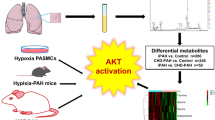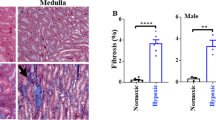ABSTRACT
The present study describes combined transcriptome and metabolome analysis for therapeutic target validation in hypoxia-induced vascular remodeling. Exposure to hypoxic conditions resulted in the upregulation of S100C mRNA and increased taurine (2-aminoethanesulfonic acid) content in the rat lung, as demonstrated by differential display and amino-acid content analysis. Hypoxia resulted in transcriptional activation of the S100C promoter through hypoxia-inducible factor-1 (HIF-1). Taurine suppressed HIF-1-mediated increases in S100C transcription. Moreover, oral taurine administration attenuated vascular remodeling in hypoxic rat lung, whereas depletion of endogenous taurine by administration of beta-alanine resulted in increased vascular remodeling. Inhibition of HIF transcription by taurine may be of therapeutic benefit in preventing hypoxia-induced vascular remodeling. In conclusion, we used transcriptome and metabolome analysis to identify a therapeutic low-molecular-weight ligand that plays a critical role in hypoxia-induced vascular remodeling. These techniques provided an excellent strategy for screening and validation of targets.
This is a preview of subscription content, access via your institution
Access options
Subscribe to this journal
Receive 6 print issues and online access
$259.00 per year
only $43.17 per issue
Buy this article
- Purchase on Springer Link
- Instant access to full article PDF
Prices may be subject to local taxes which are calculated during checkout




Similar content being viewed by others
References
Semenza GL . Perspectives on oxygen sensing. Cell 1999; 98: 281–284.
Rabinovitch M, Gamble W, Nadas AS, Miettinen OS, Reid L . Rat pulmonary circulation after chronic hypoxia: hemodynamic and structural features. Am J Physiol 1979; 236: H818–H828.
Maruyama K, Ye C, Woo M, Venkatacharya H, Lines LD, Silver MM et al. Chronic hypoxic pulmonary hypertension in rats and increased elastolytic activity. Am J Physiol 1991; 261: H1716–H1726.
Liang P, Pardee AB . Differential display of eukaryotic messenger RNA by means of the polymerase chain reaction. Science 1992; 257: 967–971.
Ito T, Kito K, Adati N, Mitsui Y, Hagiwara H, Sakai Y . Fluorescent differential display: arbitrarily primed RT–PCR fingerprinting on an automated DNA sequencer. FEBS Letters 1994; 351: 231–236.
Ohta H, Sasaki T, Naka M, Hiraoka O, Miyamoto C, Tanaka T et al. Molecular cloning and expression of the cDNA coding for a new member of the S100 protein family from porcine cardiac muscle. FEBS Lett 1991; 295: 93–96.
Nakamura T, Hayashi M, Kato A, Sawazaki T, Yasue H, Tanaka T et al. A unique Exon–Intron organization of a porcine S100C Gene. Biochem Biophys Res Commun 1998; 243: 647–652.
Mozaffari MS, Azuma J, Patel C, Schaffer SW . Renal excretory responses to saline load in the taurine-depleted and the taurine-supplemented rat. Biochem Pharmacol 1997; 54: 619–624.
Suzuki H, Kanamaru K, Tsunoda H, Inada H, Kuroki M, Tanaka T et al. Heme oxygenase-1 gene induction as an intrinsic regulation against delayed cerebral vasospasm in rats. J Clin Invest 1999; 104: 59–66.
Seemann J, Weber K, Gerke V . Annexin I targets S100C to early endosomes. FEBS Lett 1997; 413: 185–190.
Semenza GL . HIF-1 and human disease: one highly involved factor. Genes Dev 2000; 14: 1983–1991.
Kung AL, Wang S, Klco JM, Kaelin WG, Livingston DM . Suppression of tumor growth through disruption of hypoxia-inducible transcription. Nat Med 2000; 6: 1335–1340.
Maxwell PH, Wiesener MS, Cheng GW, Clifford SC, Vaux EC, Ratcliffe PJ et al. The tumour suppressor protein VHL targets hypoxia-inducible factors for oxygen-dependent proteolysis. Nature 1999; 399: 271–275.
Kim MS, Kwon HJ, Lee YM, Baek JH, Jang JE, Kim KW et al. Histone deacetylases induce angiogenesis by negative regulation of tumor suppressor genes. Nat Med 2001; 7: 437–443.
Yu AY, Simoda LA, Iyer NV, Huso DL, Sun X, Semenza GL et al. Impaired physiological responses to chronic hypoxia in mice partially deficient for hypoxia-inducible factor 1alpha. J Clin Invest 1999; 103: 691–696.
Felsder D, Agani F, Iyer NV, Pak B, Ferreira G, Semenza GL . Reciprocal positive regulation of hypoxia-inducible factor 1α and insulin-like growth factor 2. Cancer Res 1999; 59: 3915–3918.
Yu AY, Frid MG, Shimoda LA, Wiener CM, Stenmark K, Semenza GL . Temporal, spatial, and oxygen-regulated expression of hypoxia-inducible factor-1 in the lung. Am J Physiol. 1998; 275: L818–L826.
Schaffer SW, Pastukh V, Solodushko V, Kramer J, Azuma J . Effect of ischemia, calcium depletion and repletion, acidosis and hypoxia on cellular taurine content. Amino Acids 2002; 23: 395–400.
Saransaari P, Oja SS . Taurine and neural cell damage. Amino Acids 2000; 19: 509–526.
Banks MA, Martin WG, Pailes WH, Castranova V . Taurine uptake by isolated alveolar macrophages and type II cells. J Appl Physiol 1989; 66: 1079–1086.
Carpenter TC, Schomberg S, Nichols C, Stenmark KR, Weil JV . Hypoxia reversibly inhibits epithelial sodium transport but does not inhibit lung ENaC or Na–K–ATPase expression. Am J Physiol Lung Cell Mol Physiol 2003; 284: L77–L83.
Huxtable RJ . Physiological actions of taurine. Physiol Rev 1992; 72: 101–163.
ter Kuile BH, Westerhoff HV . Transcriptome meets metabolome: hierarchical and metabolic regulation of the glycolytic pathway. FEBS Lett 2001; 500: 169–171.
Naka M, Qing ZX, Sasaki T, Kise H, Tawara I, Tanaka T et al. Purification and characterization of a novel calcium-binding protein, S100C, from porcine heart. Biochim Biophys Acta 1994; 1223: 348–353.
Acknowledgements
This work was supported in part by Grants-in-Aid for Scientific Research on Priority Areas(C) from Ministry of Education, Culture, Sports, Science and Technology, and Scientific Research (A)–(C), and Exploratory Research from Japan Society for the Promotion of Science, and a Grant for Child Health and Development from the Ministry of Health, Labour and Welfare, Japan. It was also supported by the program for the promotion of Fundamental Studies in Health Sciences of the Organization for Pharmaceutical Safety and Research.
Author information
Authors and Affiliations
Corresponding author
Additional information
DUALITY OF INTEREST
None declared.
Rights and permissions
About this article
Cite this article
Amano, H., Maruyama, K., Naka, M. et al. Target validation in hypoxia-induced vascular remodeling using transcriptome/metabolome analysis. Pharmacogenomics J 3, 183–188 (2003). https://doi.org/10.1038/sj.tpj.6500177
Received:
Revised:
Accepted:
Published:
Issue Date:
DOI: https://doi.org/10.1038/sj.tpj.6500177
Keywords
This article is cited by
-
Effect of hypoxia on Ad5 infection, transgene expression and replication
Gene Therapy (2005)



